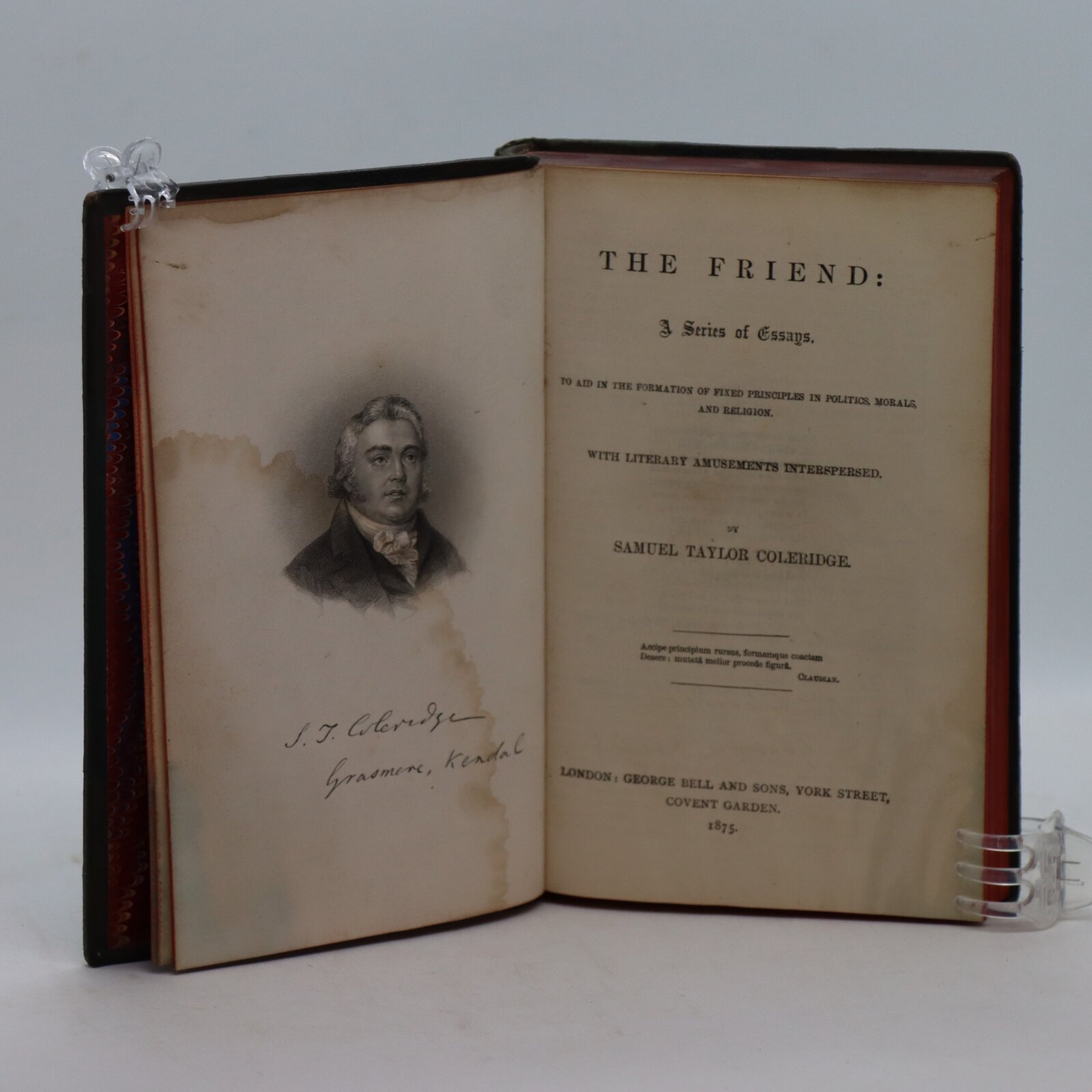The Friend. Coleridge.
By Samuel Taylor Coleridge
Printed: 1875
Publisher: George Bell & Sons. London
Edition: second edition
| Dimensions | 12 × 18 × 2.5 cm |
|---|---|
| Language |
Language: English
Size (cminches): 12 x 18 x 2.5
Condition: Fine (See explanation of ratings)
Item information
Description
Green calf binding, gilt embossed leaves on spine.
Single edition.
In 1804, he travelled to Sicily and Malta, working for a time as Acting Public Secretary of Malta under the Civil Commissioner, Alexander Ball, a task he performed successfully. He lived in San Anton Palace in the village of Attard. He gave this up and returned to England in 1806. Dorothy Wordsworth was shocked at his condition upon his return. From 1807 to 1808, Coleridge returned to Malta and then travelled in Sicily and Italy, in the hope that leaving Britain’s damp climate would improve his health and thus enable him to reduce his consumption of opium. Thomas De Quincey alleges in his Recollections of the Lakes and the Lake Poets that it was during this period that Coleridge became a full-blown opium addict, using the drug as a substitute for the lost vigour and creativity of his youth. It has been suggested that this reflects De Quincey’s own experiences more than Coleridge’s.
His opium addiction (he was using as much as two quarts of laudanum a week) now began to take over his life: he separated from his wife Sara in 1808, quarrelled with Wordsworth in 1810, lost part of his annuity in 1811, and put himself under the care of Dr. Daniel in 1814. His addiction caused severe constipation, which required regular and humiliating enemas.
In 1809, Coleridge made his second attempt to become a newspaper publisher with the publication of the journal entitled The Friend. It was a weekly publication that, in Coleridge’s typically ambitious style, was written, edited, and published almost entirely single-handedly. Given that Coleridge tended to be highly disorganised and had no head for business, the publication was probably doomed from the start. Coleridge financed the journal by selling over five hundred subscriptions, over two dozen of which were sold to members of Parliament, but in late 1809, publication was crippled by a financial crisis and Coleridge was obliged to approach “Conversation Sharp”, Tom Poole and one or two other wealthy friends for an emergency loan to continue. The Friend was an eclectic publication that drew upon every corner of Coleridge’s remarkably diverse knowledge of law, philosophy, morals, politics, history, and literary criticism. Although it was often turgid, rambling, and inaccessible to most readers, it ran for 25 issues and was republished in book form a number of times. Years after its initial publication, a revised and expanded edition of The Friend, with added philosophical content including his ‘Essays on the Principles of Method’, became a highly influential work and its effect was felt on writers and philosophers from John Stuart Mill to Ralph Waldo Emerson.
Samuel Taylor Coleridge (21 October 1772 – 25 July 1834) was an English poet, literary critic, philosopher and theologian who, with his friend William Wordsworth, was a founder of the Romantic Movement in England and a member of the Lake Poets. He also shared volumes and collaborated with Charles Lamb, Robert Southey, and Charles Lloyd. He wrote the poems The Rime of the Ancient Mariner and Kubla Khan, as well as the major prose work Biographia Literaria. His critical work, especially on William Shakespeare, was highly influential, and he helped introduce German idealist philosophy to English-speaking culture. Coleridge coined many familiar words and phrases, including “suspension of disbelief”. He had a major influence on Ralph Waldo Emerson and American transcendentalism.
Throughout his adult life, Coleridge had crippling bouts of anxiety and depression; it has been speculated that he had bipolar disorder, which had not been defined during his lifetime. He was physically unhealthy, which may have stemmed from a bout of rheumatic fever and other childhood illnesses. He was treated for these conditions with laudanum, which fostered a lifelong opium addiction.
Want to know more about this item?

Related products
Share this Page with a friend












